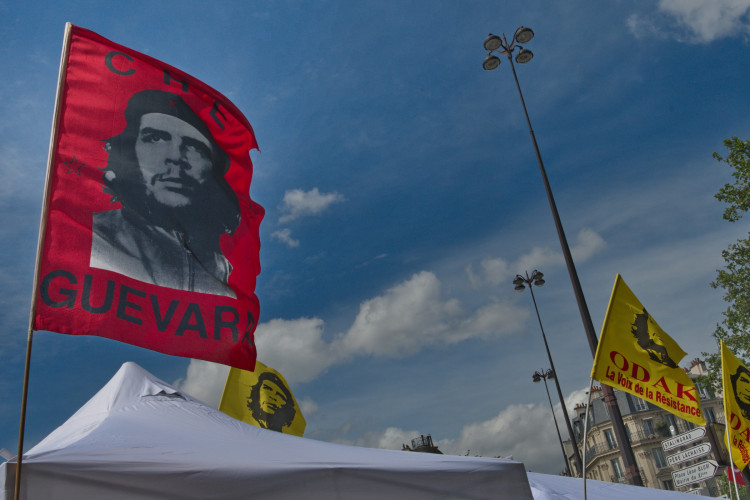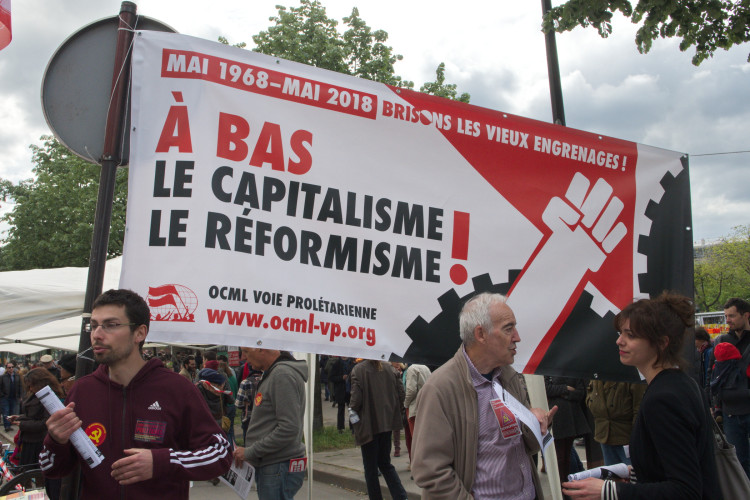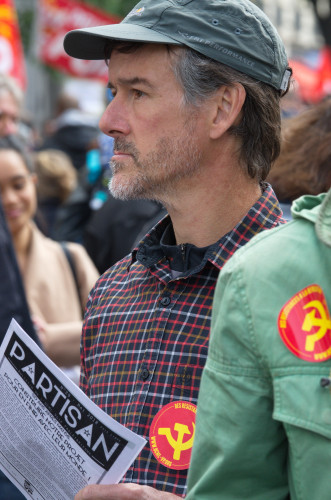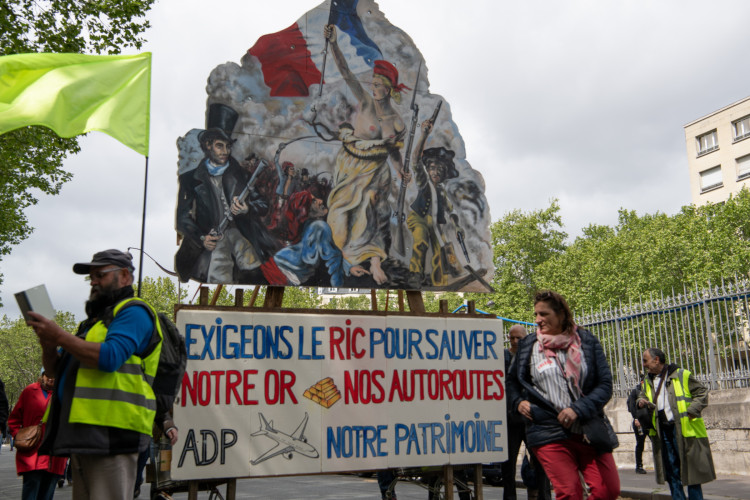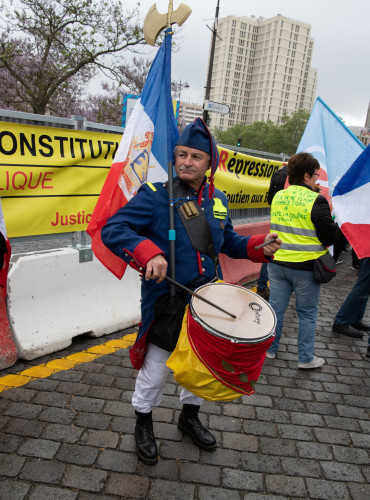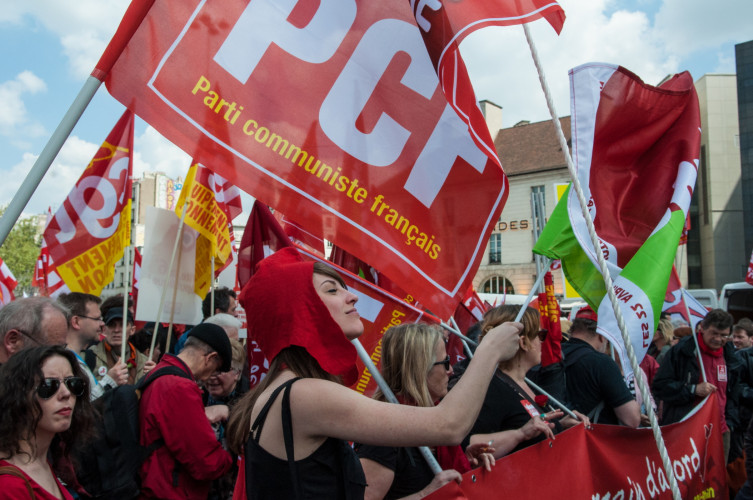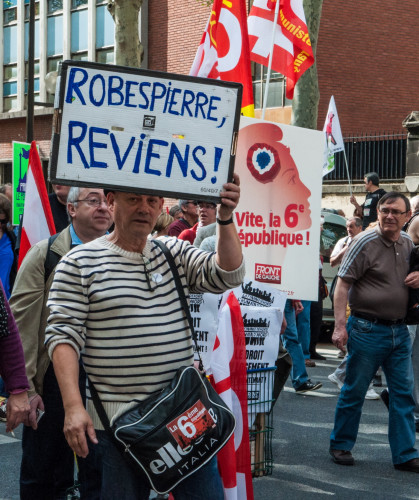The Revolution and The Commune
Photos: Leon Kunstenaar / Pro Bono Photo
If you were to attend any of the demonstrations that are convulsing Paris this Spring of 2023, you would notice references on signs, banners and walls to the two cataclysmic events that have determined French political history and that of much of the world.The first of these is the French Revolution of 1789. It created a political “Left”, an ideological orientation that considered itself devoted to human rights and a politics where all human beings can live in peace and dignity with their basic needs met.
The fires created by the French revolution still burn. The world's liberation struggles and revolutions are all heirs of that great revolution. Marx, Lenin, Mao, Ho Chi Minh, and most other great revolutionaries all politically came of age if not actually in Paris, but then as students of French history.
The revolution birthed the document called the "Rights of Man." The ideals of democracy, equality, and a society unencumbered by the oppression of classes, ethnicities, races or genders by rigid social structures, are all the heirs of this cataclysmic event.
French history, and in particular the people of Paris, lit up the world a second time with the saga of the Paris Commune of 1871.
How did this happen? Before 1789, the French nobility, living in obscene luxury, was taxing the people to the point of starvation. The nobility had forsaken its medieval tradition of protector of the peasantry during times of distress and had all decamped to the glitter of the court at Versailles, near Paris. As the State's finances were going from bad to untenable, King Louis XVI, to undermine the British Empire, agreed to substantially aid the American revolution with money and troops under LaFayette. The ensuing financial crisis led to even more extreme taxation and then, revolution.
About Lafayette, there are more streets, avenues, parks, towns, schools, and airports in the US named after him than after any historical figure. However, his reputation in France is decidedly mixed. When, in 1791, Parisians (in the field where the Eiffel tower now stands) demanded the abdication of the king and fifty were massacred, it was Lafayette who gave the order to fire.
As books and printing spread at the end of the eighteenth century, so did new political ideas. Among these were the anti-clericalism of Voltaire, who became a celebrity during his life, and Rousseau’s notions of natural law and the social contract. An emergent class of merchants and professionals, a notch above the toiling peasantry, had access to some education and a bit of leisure time in which to discuss these ideas. They were therefore able to confront the noble elites with awkward questions about justice, equality, etc. Such strange new notions also animated lively discussions in fashionable salons.
While there is nothing new about anger at the suffering caused by elites, a new element appeared in France; the notion that the people were not just the king's subjects but rather French citizens entitled to not only rights but equality before a justly administered body of law. Popular discontent was therefore given an intellectual structure, a narrative in which to operate, leading to a new radicalism, including rights for women. Radicalism became respectable to many.
Long story short, the monarchy was destroyed, the king and queen were executed and a republic established. Most of the revolution took place in the streets among the population of Paris, especially the women. There is the story of the people going to ask the king to move to Paris. To encourage to king to do so, the women of Paris harnessed themselves to cannons, dragged them the ten miles to Versailles in a torrential rainstorm and pointed them at the palace. In the ceremonial parade of the return to Paris of the king, women, rejecting the traditional role of delicate little flowers, climbed on wagons and coaches to dance and gesture obscenely. The king was now both monarch and contemptible prisoner.
In addition to establishing the people of Paris as the main mover of French protest, a new politics, the left, was created. It is still a work in progress.
The Revolution was a practical disaster. A counter-revolution was attempted, leading to the greatest systematic slaughter seen up to that time. The surrounding monarchies invaded. To defeat them the French invented yet something new; the "Guerre a Outrance," the war to mass involvement and exhaustion of all men, women and children. Women demanded to be armed and sent into battle and not just do the cooking and tending to the wounded. Children were set to washing bandages.
An artillery officer named Napoleon seized power and crowned himself emperor. He established a military dictatorship, destroyed much of Europe and France did not become a functioning republic for another hundred years.
How France became a real republic in 1871 again reinforces the country's, and especially that of the people of Paris', centrality as the creator of the political narrative of the left.
In 1870, Napoleon III, Napoleon’s nephew, was emperor of France. Germany was a bunch of separate political entities with Bismarck working to unite them with a series of wars. Turns out that there was a vacancy on the Spanish throne and there was a plan to put a German on it. The French were unhappy with this as they did not want German monarchs on both their southern and eastern borders.
So they sent their diplomats to Spain to kindly ask them not to do this. The Spanish were quite accommodating and said "no problem, we won't." The French diplomats sent letters back to Paris with the good news.
However, Bismarck’s agents intercepted the letters and substituted ones with a very different message. The substitute letters said that the Spanish had insulted the French diplomats and told them to get lost. The French, their “honneur” offended, declared war on Germany, setting in motion events that would inspire future leftist revolutions throughout the world.
The war of 1870 was a disaster for France. The Germans even captured and ransomed the French emperor. Enter now the people of Paris who refused to accept the French defeat. With the government having exiled itself at Versailles and the German army still around Paris, the people of Paris, mostly the poor, with their fierce national identity undimmed since the great revolution, revolted. They declared the Paris Commune with its own government and public institutions. The country was now, effectively, in a civil war between the working people of Paris and the government at Versailles.
The Commune lasted from March 18, 1871 to May 28 1871, seventy-two days. Defeat by troops of the Versailles government was horrific. Close to 20,000 people were massacred with the brutality of those who had seen their whole social structure challenged by bold new revolutionary institutions,
Indeed, just as the 1789 revolution had done, society’s norms had been upended. The Commune tried to implement an egalitarian society. Free and equal education for boys and girls was established and the state took the school system away from the Church. “Natural” children were made equal in status to those born to the married. Men no longer had legal control over their wives. Workers' cooperatives were created. Women had property rights, could demand divorce, and enter the professions. They could and were elected to positions of leadership.
Karl Marx described the Commune as the “glorious harbinger of a new society”. Lenin saw it as the forerunner to the Russian revolution. In 1936, in the days of France’s anti-fascist Popular Front government, 500,000 leftists made the pilgrimage to the Père Lachaise cemetery in Paris to honor the Commune’s martyrs. *
*Julian Coman. Vive la Commune? The working-class insurrection that shook the world, The Guardian, March 7, 2021
France’s great intellectuals such as Flaubert, Victor Hugo and Emile Zola, who had written eloquently about the plight of the working class, did not support the Commune. While sympathy for the oppressed was all well and good, challenges to the patriarchy and male supremacy was an entirely different matter. After all, they themselves were among the elites.
Still today, the Commune generates controversy. Commemorations of the Commune recently implemented by Paris’ mayor, Ann Hildago, ran into opposition from some conservative politicians. The principles of challenge to established order, both religious and secular, as symbolized by the Commune, are still relevant.
However, the story of the Commune remains today a foundational narrative to those on the left who yearn for “Liberté, Egalité, Fraternité.”
Cut down, just as it had germinated, grown, the Commune suffered a bitter end. But it did not fail. It persists as a guide to multiple radically different goals.
In the century and the a half since the 1871 revolt, the Commune has stood as inspiration to a plethora of activist and global movements.
In 1879, in Chicago, nearly 60,000 people celebrated the Commune with a “program of singing, dancing, and drilling” organized by the Workingman’s Party of Illinois in 1889. In 1889, in Alexandria, Egypt, anarchist printers on March 18 marked the “eighteen long years past the day since the Commune. In the early 20th century, anarchist feminist Voltarine de Clyre and Emma Goldman each credited the Commune as an inspiration. Vladimir Lenin studied and emulated aspects of the Commune in the approaches to revolution in Russia (the Commune flag shrouded his body at his 1929 death). In 1925, the New York Workers Party of America commemorated the revolutionary anniversary with over 10,000 attendees in Madison Square Garden. In 1927 and again in 1967, workers formed the Shanghai Commune. Occupy Oakland formed the “Oakland Commune” in 2011 and in 2020, the artist Banksky funded the “Louise Michele,” a rescue ship in the Mediterranean Sea. The Commune is sufficiently capacious to hold all these and more, past and future, under its liberatory umbrella.*
*Eichner, Carolyn J. The Paris Commune, p103. Rutgers University Press, 2022
Also see: Occupy Oakland is dead. Long live the Oakland Commune
The Commune will be commemorated again this year in Paris on May 18. It will be a theatrical event at the site of a massacre of revolutionaries during the “bloody week of 1871” I will be there.
The republic, called the Third Republic, lasted till Germany, again, invaded in 1940. As France lost its colonial empire after WW2 and particularly with the Algerian war, the country’s Fourth Republic, established after the German defeat, devolved into crisis. In 1958, De Gaulle stepped in and, demanding a new constitution, established the Fifth Republic.
And here lies the reason for the current mass demonstrations in Paris. The constitution of the Fifth Republic contains an article, no 49.3., that was inserted to prevent government paralysis during budgetary deliberations. The article allows the government to force the adoption of financial measure it deems essential. DeGaulle had demanded a constitution with a President having almost monarchical power. When article 49.3 is invoked, the government is subject to a vote of confidence. If it loses, the cabinet is dismissed and new legislative elections must be held. Otherwise, the constitutionality of the measure must then be evaluated by a “constitutional council” of 9 “sages”, three selected by the president, three by the president of the senate and three by the president of the national assembly. On this, the measure wins or fails.
President Macron whose arrogant demeanor has earned him the nickname of “Jupiter” and who is widely seen as a representative of the corporate elite, decided that French working people could not retire till age sixty four instead of the current official retirement age of sixty two. This is another gift to the corporate elite, allowing the gains of increased productivity from technological progress to accrue to the wealthy while denying such gains to those who had produced them.
His claim that the retirement system is in imminent danger of insolvency has been widely debunked by many economists, including those working within the government. In order to avail himself of article 49.3, he then framed the change in retirement age as a financial measure and not as a social policy measure.
Seeing that he did not have the votes to pass the retirement age change, Macron invoked article 49.3. He won the following confidence vote by nine votes out of 577. The decision by the constitutional council is imminent.
Polls indicate that 70% of the French are opposed to the “reform.” They further see his maneuvers to pass the retirement age change as anti-democratic in spirit and a blatant violation of the national will. Huge demonstrations are wracking Paris and other cities. Sympathy actions are occurring in Belgium. Unions are more united in opposition than they have been since 1968 when protests forced DeGaulle to flee Paris in a helicopter. The government was almost overturned.
Parisians are again in the streets making history.
Get Involved
If you'd like to help with maintaining or developing the website, contact us.
Publish
Publish your stories and upcoming events on Indybay.



